Galaxy Clusters
Galaxies
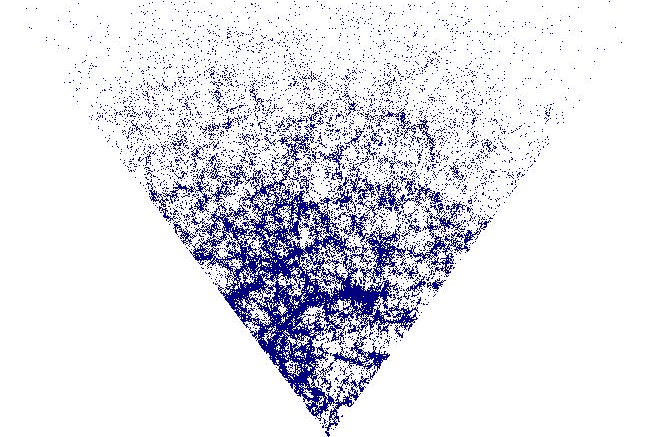 Galaxies are not smoothly distributed across the sky (right-hand
image). There are small regions of high galaxy density and large areas
encompassing only relatively few galaxies. The distributions of
galaxies on the sky shows a net-like structure in which thin walls and
filaments surround large voids. Galaxy clusters are the nodes of this
network.
The right-hand image shows part of the galaxy distribution measured by
the 2dF Galaxy Redshift
Survey.
Galaxies are not smoothly distributed across the sky (right-hand
image). There are small regions of high galaxy density and large areas
encompassing only relatively few galaxies. The distributions of
galaxies on the sky shows a net-like structure in which thin walls and
filaments surround large voids. Galaxy clusters are the nodes of this
network.
The right-hand image shows part of the galaxy distribution measured by
the 2dF Galaxy Redshift
Survey.
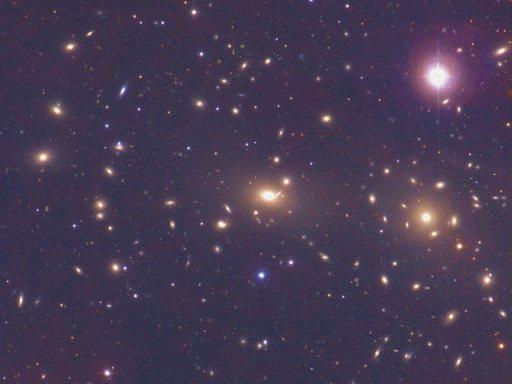 Individual galaxy clusters contain some hundred up to a thousand
galaxies. The right-hand picture shows the Coma cluster. Almost all
objects are galaxies, most of them elliptical. Spiral galaxies are
rare in galaxy clusters. Typical diametres of galaxy clusters are
several mega-parsec (1 Mpc = 3.3 million light years).
The galaxies move within galaxy clusters with velocities up to
approximately 1000 km/s. At that speed they need several billion years
to cross typical galaxy clusters.
Fritz Zwicky found already in the 1930s that the mass of all galaxies
in the Coma cluster together is by far insufficient for binding the
galaxies to each other. From that he concluded that some 90% of the
matter in galaxy clusters does not shine and this thus dark
matter. Galaxy clusters have typical masses between 1014
und 1015 solar masses.
Individual galaxy clusters contain some hundred up to a thousand
galaxies. The right-hand picture shows the Coma cluster. Almost all
objects are galaxies, most of them elliptical. Spiral galaxies are
rare in galaxy clusters. Typical diametres of galaxy clusters are
several mega-parsec (1 Mpc = 3.3 million light years).
The galaxies move within galaxy clusters with velocities up to
approximately 1000 km/s. At that speed they need several billion years
to cross typical galaxy clusters.
Fritz Zwicky found already in the 1930s that the mass of all galaxies
in the Coma cluster together is by far insufficient for binding the
galaxies to each other. From that he concluded that some 90% of the
matter in galaxy clusters does not shine and this thus dark
matter. Galaxy clusters have typical masses between 1014
und 1015 solar masses.
Hot Gas
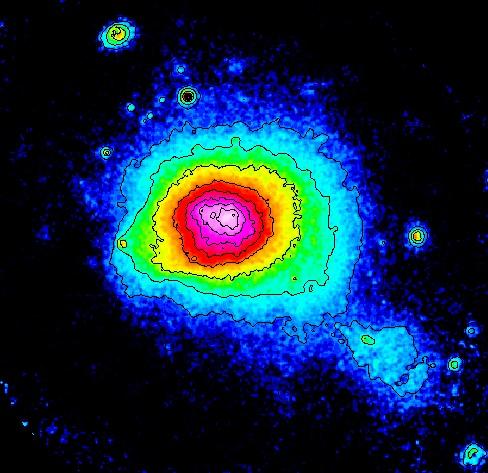 The first X-ray telescopes discovered that galaxy clusters are intense
X-ray emitters. The X-ray radiation is not concentrated on individual
galaxies but diffusely distributed across the clusters. This radiation
is emitted by hot gas filling the galaxy clusters. It has temperatures
from 107 to 108 degrees Kelvin. The right-hand
image shows the X-ray emission of the Coma cluster.
The X-ray emission is very important for determining the mass
distribution and the dynamics of the galaxy clusters. Modern X-ray
telescopes like Chandra and XMM have found detailed structures in the
cores of galaxy clusters.
The first X-ray telescopes discovered that galaxy clusters are intense
X-ray emitters. The X-ray radiation is not concentrated on individual
galaxies but diffusely distributed across the clusters. This radiation
is emitted by hot gas filling the galaxy clusters. It has temperatures
from 107 to 108 degrees Kelvin. The right-hand
image shows the X-ray emission of the Coma cluster.
The X-ray emission is very important for determining the mass
distribution and the dynamics of the galaxy clusters. Modern X-ray
telescopes like Chandra and XMM have found detailed structures in the
cores of galaxy clusters.
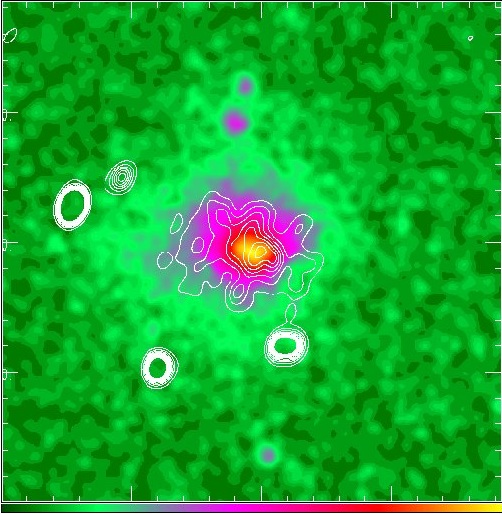 The cosmic microwave background (CMB) shines through the hot gas in
galaxy clusters. In passing the gas, the photons of the CMB are
scattered to higher energies. This leads to a small distortion of the
Planck spectrum of the CMB because after scattering photons at low
energies are missing which reappear at higher energies. The zero point
of this so-called Sunyaev-Zel'dovich effect is at 217 GHz
(approximately 1 mm wave length). At lower frequencies galaxy clusters
cast shadows, while they shine at higher frequencies. This effect
allows the detection of galaxy clusters out to very large distances.
The left-hand image shows the X-ray emission of the galaxy cluster
Abell 2163 (colour) with the contours of the Sunyaev-Zel'dovich effect
overlaid.
The cosmic microwave background (CMB) shines through the hot gas in
galaxy clusters. In passing the gas, the photons of the CMB are
scattered to higher energies. This leads to a small distortion of the
Planck spectrum of the CMB because after scattering photons at low
energies are missing which reappear at higher energies. The zero point
of this so-called Sunyaev-Zel'dovich effect is at 217 GHz
(approximately 1 mm wave length). At lower frequencies galaxy clusters
cast shadows, while they shine at higher frequencies. This effect
allows the detection of galaxy clusters out to very large distances.
The left-hand image shows the X-ray emission of the galaxy cluster
Abell 2163 (colour) with the contours of the Sunyaev-Zel'dovich effect
overlaid.
Magnetic Fields
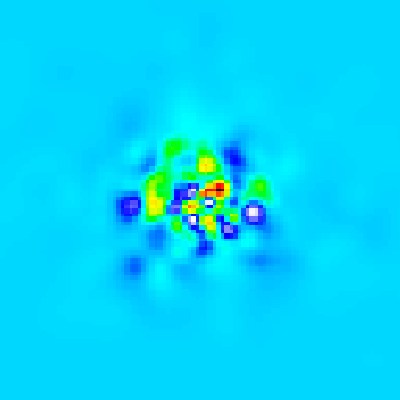 Galaxy clusters are pervaded by large-scale magnetic fields. They
become visible because a magnetised plasma is optically
bi-refringent. When propagating parallel to the magnetic field, left-
and right-polarised light experience slightly different indices of
refraction. This gives rise to a rotation of the polarisation
direction of linearly polarised light. This so-called Faraday rotation
is measurable because the degree of the rotation depends on the wave
length of the polarised light. Measurements of the Faraday rotation
are difficult but allow the magnetic field structure in the interiour
of galaxy clusters to be studied. The right-hand image shows the
Faraday rotation measure in a simulated galaxy cluster (red and blue
encode different senses of rotation).
Galaxy clusters form by merging of smaller objects. Such merger
processes are highly energetic and often occur at supersonic
velocities. Accordingly, they drive shock waves into the intracluster
plasma which accelerate electrons to relativistic velocities. Those
electrons spiral around the magnetic field lines and emit synchrotron
radiation which is measurable as diffuse radio emission in galaxy
clusters.
Galaxy clusters are pervaded by large-scale magnetic fields. They
become visible because a magnetised plasma is optically
bi-refringent. When propagating parallel to the magnetic field, left-
and right-polarised light experience slightly different indices of
refraction. This gives rise to a rotation of the polarisation
direction of linearly polarised light. This so-called Faraday rotation
is measurable because the degree of the rotation depends on the wave
length of the polarised light. Measurements of the Faraday rotation
are difficult but allow the magnetic field structure in the interiour
of galaxy clusters to be studied. The right-hand image shows the
Faraday rotation measure in a simulated galaxy cluster (red and blue
encode different senses of rotation).
Galaxy clusters form by merging of smaller objects. Such merger
processes are highly energetic and often occur at supersonic
velocities. Accordingly, they drive shock waves into the intracluster
plasma which accelerate electrons to relativistic velocities. Those
electrons spiral around the magnetic field lines and emit synchrotron
radiation which is measurable as diffuse radio emission in galaxy
clusters.
Gravitational Lensing
Due to their large mass, galaxy clusters deflect light. They act as gravitational lenses.Verantwortlich: Matthias Bartelmann


